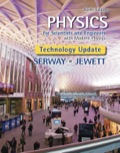
(a)
The relation among the currents using Kirchhoff’s law.
(a)
Answer to Problem 70AP
The relation among the currents using Kirchhoff’s law is
Explanation of Solution
Apply Kirchhoff’s junction rule which states that at any junction the sum of the cuurent must be equal to zero.
Here,
Therefore, the relation among the currents using Kirchhoff’s law is
(b)
The relation using Kirchhoff’s rule in the left loop.
(b)
Answer to Problem 70AP
The relation using Kirchhoff’s rule in the left loop is
Explanation of Solution
Apply Kirchhoff’s loop rule in the left loop.
Here,
Rearrange equation (I) to get the expression for
Substitute
Therefore, the relation using Kirchhoff’s rule in the left loop is
(c)
The relation using Kirchhoff’s rule in the outer loop.
(c)
Answer to Problem 70AP
The relation using Kirchhoff’s rule in the outer loop is
Explanation of Solution
Apply Kirchhoff’s rule in the outer loop.
Substitute
Therefore, the relation using Kirchhoff’s rule in the outer loop is
(d)
The equation involving only current.
(d)
Answer to Problem 70AP
The equation involving only current is
Explanation of Solution
Multiply and divide left hand side of equation (IV).
Therefore, the equation involving only current is
(e)
The given expression.
(e)
Answer to Problem 70AP
The given equation
Explanation of Solution
Equation (V) is of the form.
The solution to equation (V) is
Compare equation (V), (VI) and (VII) for the value of
Substitute
Therefore, the given equation
Want to see more full solutions like this?
Chapter 32 Solutions
Physics for Scientists and Engineers with Modern Physics Technology Update
- At t = 0, the open switch in Figure P31.46 is thrown closed. We wish to find a symbolic expression for the current in the inductor for time t 0. Let this current be called i and choose it to be downward in the inductor in Figure P31.46. Identify i1 as the current to the right through R1 and i2 as the current downward through R2. (a) Use Kirchhoffs junction rule to find a relation among the three currents. (b) Use Kirchhoffs loop rule around the left loop to find another relationship. (c) Use Kirchhoffs loop rule around the outer loop to find a third relationship. (d) Eliminate i1 and i2 among the three equations to find an equation involving only the current i. (e) Compare the equation in part (d) with Equation 31.6 in the text. Use this comparison to rewrite Equation 31.7 in the text for the situation in this problem and show that i(t)=R1[1e(R/L)t] where R = R1R2/(R1 + R2). Figure P31.46arrow_forward(a) If an inductor carrying a 1.95 A current stores an energy of 0.250 mJ, what is its inductance? Answer in mH (b) How much energy does the same inductor store if it carries a 3.1 A current? Answer in mJarrow_forward
 Principles of Physics: A Calculus-Based TextPhysicsISBN:9781133104261Author:Raymond A. Serway, John W. JewettPublisher:Cengage Learning
Principles of Physics: A Calculus-Based TextPhysicsISBN:9781133104261Author:Raymond A. Serway, John W. JewettPublisher:Cengage Learning Physics for Scientists and EngineersPhysicsISBN:9781337553278Author:Raymond A. Serway, John W. JewettPublisher:Cengage Learning
Physics for Scientists and EngineersPhysicsISBN:9781337553278Author:Raymond A. Serway, John W. JewettPublisher:Cengage Learning Physics for Scientists and Engineers with Modern ...PhysicsISBN:9781337553292Author:Raymond A. Serway, John W. JewettPublisher:Cengage Learning
Physics for Scientists and Engineers with Modern ...PhysicsISBN:9781337553292Author:Raymond A. Serway, John W. JewettPublisher:Cengage Learning Physics for Scientists and Engineers, Technology ...PhysicsISBN:9781305116399Author:Raymond A. Serway, John W. JewettPublisher:Cengage Learning
Physics for Scientists and Engineers, Technology ...PhysicsISBN:9781305116399Author:Raymond A. Serway, John W. JewettPublisher:Cengage Learning Physics for Scientists and Engineers: Foundations...PhysicsISBN:9781133939146Author:Katz, Debora M.Publisher:Cengage Learning
Physics for Scientists and Engineers: Foundations...PhysicsISBN:9781133939146Author:Katz, Debora M.Publisher:Cengage Learning




